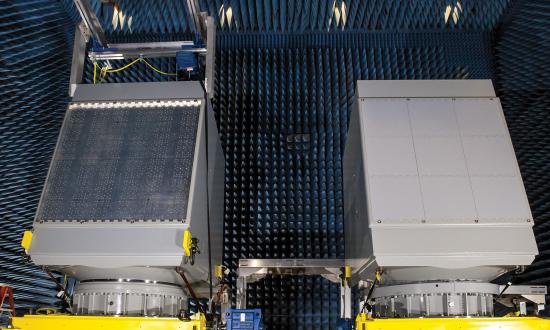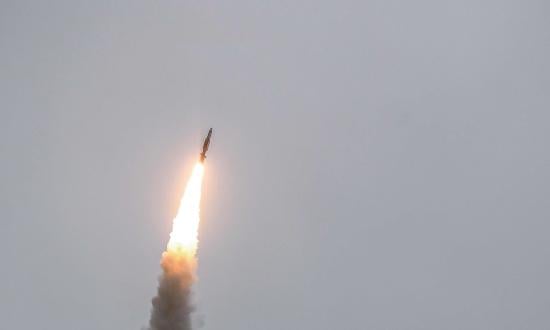Proceedings recently interviewed Navy Vice Admiral Jon A. Hill, Director, Missile Defense Agency. He provides valuable insights into the current state of the missile threats to the United States, its allies, and U.S. military forces deployed around the world.
Proceedings: A decade or two ago, it seemed that the focus for U.S. missile defense was on rogue actors, especially North Korea and Iran, who were developing small numbers of medium- and long-range ballistic missiles that could threaten our allies in Europe, the Middle East, Asia, and parts of the United States. The 2018 National Defense Strategy put the focus squarely on great power competition with China and Russia, both of which have bigger and more complex arsenals of intercontinental ballistic missiles (ICBMs), submarine-launched ballistic missiles (SLBMs), and long-range, high-speed cruise missiles. How has that changed MDA's work and sense of urgency?
Hill: The previous administration drafted the 2018 National Defense Strategy. That strategy, which the current administration has continued, advanced the policy of relying on nuclear deterrence to protect against large and technically sophisticated Russian and Chinese intercontinental missile threats to the U.S. homeland. Defending against near-peer missile threats is cost-prohibitive and is not technically feasible. MDA is continuing its plan, in alignment with the current National Defense Strategy and missile defense policy, of developing and deploying homeland missile defense capabilities to address the limited but growing rogue-state offensive missile threats. At the same time, to address regional missile threats from any adversary, MDA is developing and deploying credible capabilities for regional defense. The sense of urgency to develop and deploy credible and effective missile defenses remains high, as it has over the past 10 to 15 years, because U.S. adversaries, including China and Russia, continue to invest in more capable ballistic, hypersonic, and cruise missiles—systems with global reach, increased speed and maneuverability, greater accuracy, and improved countermeasures.
Current missile defense policy recommends a comprehensive approach to prevent and defeat adversary attacks through a combination of: deterrence; if deterrence fails, attack operations to destroy offensive missiles prior to launch; and active and passive missile defenses. This comprehensive approach strengthens our ability to protect the U.S. homeland, U.S. forces abroad, allies, and partners; deters adversary threats and attacks; assures allies and partners; engages in diplomacy from a position of strength; hedges against future risk; and preserves our freedom of action to conduct regional military operations in defense of our interests.
In sum, current U.S. Government policy identifies three principles governing U.S. missile defenses:
- U.S. homeland missile defense will stay ahead of rogue states’ missile threats
- Missile defense will defend U.S. forces deployed abroad from the full spectrum of missile threats from any source and support the security of allies and partners
- The United States will pursue new concepts and technologies to stay ahead of growing offensive threats posed by ballistic, cruise, and hypersonic missiles
missile test. (U.S. Navy)
Proceedings: As a follow-up, what's your top concern today? China? Russia? North Korea? A specific threat capability?
Hill: At the regional level, the missile development efforts and fielding plans of China, Russia, North Korea, and Iran, remain concerning. The threats posed by ballistic missile delivery systems are likely to increase and grow more complex. Adversary ballistic missile systems are becoming more mobile, survivable, reliable, and accurate while also achieving longer ranges. Maneuvering hypersonic glide vehicles delivered by ballistic missile boosters are an emerging threat that will pose new challenges to missile defense. Increasing technical and operational countermeasures continue to challenge defensive systems. The ballistic and cruise missile threat continues to increase with the advancement and proliferation of missile technology. The cruise missile threat to U.S. forces also is increasing. The majority of land-attack cruise missiles (LACMs) will still be subsonic, but supersonic threat missiles have already been fielded, and hypersonic missiles will be deployed in the future. LACMs will also have greater survivability by minimizing radar signatures and increasing the use of countermeasures.
With respect to threat capabilities, we must be concerned about all of them—ballistic, hypersonic, and cruise missile—at the same time. New ballistic missile systems feature multiple independently targetable reentry vehicles (MIRV) and maneuverable reentry vehicles (MaRV), along with decoys and jamming devices. Russia and China are developing advanced cruise missiles that can be launched from aircraft, ground launchers, ships, and submarines, and hypersonic missiles that can travel at exceptional speeds with unpredictable flight paths that challenge existing defensive systems. These are challenging realities of the emerging missile threat environment that U.S. missile defense policy, strategy, and capabilities must address.
As I mentioned earlier, potential adversaries are developing hypersonic missiles to bypass perceived U.S. missile defense capabilities. Regional hypersonic missiles are capable of holding deployed U.S. forces, allies, and partners at risk. Russia and China continue to expand the capability and capacity of their regional offensive missile inventories, to include hypersonic missiles. China has fielded, can field, or is close to fielding, hypersonic delivery systems for conventional prompt strike that can reach thousands of kilometers from the Chinese shore and hold U.S. carrier strike groups or forward-deployed forces on land bases at risk. In late 2019, Russia deployed the world’s first ICBM-class hypersonic glide vehicle system, the SS-19 Mod-4 Avangard. Consistent with long-standing U.S. policy, MDA is not developing or deploying capabilities to defend the U.S. homeland against near-peer strategic hypersonic missile threats, as we rely on nuclear deterrence to address these more complex threats.
(Credit: Sputnik)
North Korean offensive capabilities against the United States continue to dominate our attention. North Korea has a strong desire to develop long-range ballistic missile systems that can threaten the United States and its allies, and it has been the source of ballistic missile-associated sales to numerous countries and still presents a significant proliferation threat. Iran, like North Korea, also is proliferating offensive missile technology presenting additional threats to the U.S., allies, and partners. Iran continues to develop more sophisticated missiles with improved accuracy, range, and lethality. It fields an array of increasingly accurate short- and medium-range ballistic missile systems capable of threatening deployed U.S. forces, allies, and partners.
Another evolving concern is cybersecurity. Our adversaries and strategic competitors will increasingly use offensive cyber capabilities—including cyber espionage, attack, and influence—to seek political, economic, and military advantage over the United States and its allies and partners. MDA continues to make significant progress in cybersecurity by incorporating system-level requirements into system specifications and then implementing rigorous evaluation-based testing and assessments.
Bottom line, missiles will continue to be a threat in future conflicts involving the U.S. homeland, forces, allies, and international partners.
Proceedings: Several Proceedings articles in the past few years have highlighted the missile-exchange cost problem for the U.S. Navy. China can shoot lots of missiles at U.S. carrier strike groups and bases in Asia. Defending against those missiles could require shooting two or three times as many missiles back. How are you addressing that salvo cost imbalance?
Hill: The Missile Defense System (MDS) is designed to incorporate and handle multiple attacks from our adversaries, and as we improve the system's performance, we improve its capability to handle more stressing raids. To accomplish this, MDA is improving sensing and discrimination to allow for higher effectiveness of the missiles we fire. Better information sharing between the MDS and deployed forces will provide early warning and tracking information earlier in an attacking missile's flight and targeting information for offensive, counter-force operations. We are also developing technology for non-kinetic engagement options (directed energy) and improving electronic counter-countermeasures. Attacking multiple targets per interceptor missile would also help mitigate the challenges posed by enemy salvo launches.
In addition to what MDA is delivering, the Navy will continue to develop air- and missile- defense weapons to protect the fleet against supersonic and subsonic cruise missiles, drones, and enemy aircraft. The Navy is investing in Integrated Fire Control to fight weapons and forces over the horizon, shipboard electronic warfare and directed energy (laser) weapons, Standard Missile and Evolved Sea Sparrow Missile improvements, and improved situational awareness and fire- control data sharing between forces.
The joint force is increasing its capability to strike enemy missiles before they launch. MDA, in partnership with other DoD elements, the combatant commands, and the Intelligence Community (IC), has created and is executing an integrated missile defense strategy to align and enhance the spectrum of U.S. pre-launch, launch, and post-launch missile defeat capabilities. The strategy’s framework, known as “Left-Through-Right-of-Launch Integration,” seeks to enhance sharing of data, technologies, and capabilities across warfighter, policy, intelligence, and acquisition organizations.
This is a “whole-of-defense” effort. No defense is perfect, but some defenses can be significant. When deterrence fails, the nation will need active defenses to protect leadership, defend critical infrastructure, and safeguard the strike assets we will need to execute a counterstrike. Missile defenses provide a level of protection against attacks and raids. Without these defenses, the United States and its friends and allies would be vulnerable to coercion, intimidation, and attack. Therefore, even an imperfect missile defense system is better than none at all. Missile defense systems limit the military utility of enemy offensive missile systems and lower the operational importance of such systems.
Proceedings: What technologies are you most excited about? Are high-power lasers or microwave weapons the future of missile defense?
Hill: MDA invests in several innovative and disruptive technologies to address the emergence of new and more advanced threats. To be responsive to evolving missile threats, we must continue to sustain, modernize, and expand missile defenses by pursuing rapid, yet measured development of advanced missile-defense concepts and technologies for homeland and regional defense.
MDA is investing in technology for the next increment of capability, including internally cooled seekers, axial upper stage capability, robust and resilient materials for hypersonic flight, and novel guidance and control capabilities. We are pursuing the next hypersonic defense interceptor and off-board sensor support, such as cavity-backed seeker technology, solid propulsion, datalink technology, large-format focal-plane arrays, and cryocoolers.
ground-based interceptor. (Credit: Missile Defense Agency)
Working with Office of the Under Secretary of Defense for Research and Engineering, we are excited about the possible missile defense applications of directed energy. We have invested in directed-energy kill mechanisms, including multiple laser types, high-powered microwave, and component technologies to support development of sensors and interceptors, such as beam control and lethality. We are developing two 100-kilowatt class laser technologies for transition from two national laboratories to industry. Our goal is to foster competition in industry and accelerate the pace of development. While technical hurdles remain to making these systems operationally viable, MDA is on track to achieve 100-kilowatt class performance for coherently combined fiber combined laser technology this fiscal year. We anticipate similar performance capability with the diode pumped alkali laser (DPAL) technology.
MDA continually assesses emerging and disruptive technology for potential applications to missile defense utilization. We are pursuing efforts in artificial intelligence, machine learning, nanosat technology, left-through-right integration, cybersecurity, and quantum science.
Proceedings: How does MDA coordinate or control the efforts of the individual services as they develop service-specific capabilities? AEGIS, THAAD, Patriot, ground-based missile defense, plus associated C4ISR. There are a lot of programs that seemingly overlap and need to be integrated. How are those efforts going?
Hill: The Warfighter Involvement Process (WIP), led by U.S. Strategic Command, is essential for cross coordinating all Combatant Commands and Services and results in a single set of prioritized requirements to drive MDA investment. The WIP, coupled with the Department’s missile defense governance process (consisting of the Missile Defense Executive Board and its five Standing Committees), has enabled MDA’s ongoing and collaborative relationships with Combatant Commands to address evolving threats. Similarly, the Agency continues to maintain strong partnerships with the services and military departments through our Service/MDA Board of Directors Meetings, in addition to the day in/day out technical, programmatic, and sustainment support we provide.
Over the past year, MDA responded to and supported the combatant commanders and services by delivering and sustaining sensors, battle management, and engagement systems—all while adhering to DoD pandemic measures. MDA provides sustainment support to the lead services around the clock for virtually every individual component of the Missile Defense System, including testing, integration, system and software certification, missile maintenance and recertification, and technical and logistics support.
Proceedings: How would you recommend we educate and prepare today’s officers for warfare that is “beyond human speed?” Does military science-technology-engineering-math curricula need to include advanced application to officers’ primary warfighting duties?
Hill: Technology is advancing at a blinding rate and so are weapons capabilities employed by and faced by the Navy and Marine Corps. Today’s naval officers need to advance intellectually at the same exponential rate that technology is embedding into our networks and combat systems. If they do not, it is unlikely that new capabilities will be effectively acquired or employed. Our operators must understand and master the technology needed to achieve a common tactical picture in a dense operating environment. They must understand the complex, joint warfare system architecture to be able to detect, control, and engage multiple, simultaneous, maneuvering hypersonic targets inbound from multiple threat axes. It is a daunting task, but to help meet it the Naval Postgraduate School (NPS) and the Missile Defense Agency collaborated to establish the Rear Admiral Wayne E. Meyer Program. Named in honor of the “Father of AEGIS,” the Meyer Program has the objective of developing officers who are exceptionally qualified to acquire and employ advanced naval warfare capabilities. For more information about this program, interested officers can contact John Hammerer, Integrated Air and Missile Defense Chair at NPS, john.hammerer@nps.edu.
Proceedings: Admiral Hill, thank you for your time and in-depth answers. Clearly, you have a lot on your plate!
Note: Admiral Hill recently spoke to an audience at NPS as part of their Secretary of the Navy Guest Lecture Series.









